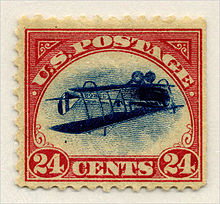Variety (philately)
Under modification refers to a deviation in Stamps of pressure , perforation or gumming of the intended result. In some cases, such postage stamps have a certain collector's and commercial value, which can be considerable.
Print types
Copy
A copy is a reversed, more or less exactly upright imprint of the stamp image on the back of the stamp. A set may have been caused by the idling of the printing press (the next inserted sheets receive a set). In this case it is called machine imitation . This is always congruent with the picture on the front. The philatelist calls the second type of impression a sheet impression . This is caused by insufficient drying of the sheets during the printing process. The sheet copy is usually shifted and not congruent with the stamp image on the front.
Overprint error
Imprints are made in order to change the postage value of a postage stamp or to apply additional / changed information to an existing stamp issue. Errors are common when printing on postage. The most important are:
- Imprint of a wrong value in a series (mix-up)
- Upside down print (sheet inserted upside down)
- Missing imprints
- Imprints on rubber side (sheet inserted the wrong way round)
- Double printing (see double printing)
- Strongly shifted overprints
- Typesetting and plate errors (see plate errors )
Print run failure
Due to a technical defect in the printing machine, one or more colors may be missing in the drawing.
Double press
Double prints are created by running the sheet twice through the printing machine. When you double-print, the second image is always shifted a little.
From 1948 onwards it often happened in the issues of the FRG, Berlin and the GDR that only one color was printed twice on multi-colored stamps. However, these stamps are often confused with the so-called Schmitzdruck and are no longer checked by BPP.
Color misprint
Color misprint is the printing of a mark (or part) in the wrong color. It can also happen that the colors are printed in the wrong sequence, so that new, sometimes very different color nuances arise. Color misprints with shifted color also occur relatively frequently. A single color z. T. printed shifted by a few millimeters. Well known here is the “Kingfisher with Snow Fur”, a Swiss postage stamp on which, thanks to the shifted color, a depicted kingfisher shows a wide white stripe on the back.
Rubber side print
An already gummed sheet is inserted upside down in the printing machine. This means that the stamps are printed on the rubber side.
Upside down print
One speaks of upside-down printing when part of the stamp (e.g. airplane) is placed upside down in the printing plate and so this part on the stamp is also upside down (airplane flies upside down).
Watermark variety
A watermark variant is the printing of stamps on paper with a watermark that was not intended for this issue, as well as incorrect positions of a watermark (e.g. upside down) on a stamp issue intended for this purpose. The best-known watermark variant of the German postage stamps is probably the so-called four-pass watermark from the inflation period of the German Empire.
Perforation varieties
Partial teeth
A defective perforation machine can cause one or more pages of a stamp to remain imperforated. It happens relatively often that individual tooth holes are not punched (so-called blind teeth).
Gears
Careless and inaccurate insertion of the already printed stamps into the perforation machine results in smaller or larger teeth. This means that the perforation does not run in the intended places, but sometimes through the middle of the stamp.
Size differences
Especially in the area of the German Empire in the Pfennige / Pfennig and the Krone / Adler series there were some massive differences in size of the individual stamps, whereby one basically differentiates between the four different varieties narrow, narrowed, widened and wide.
Print scrap
Usually such brands are sorted out immediately. Such stamps can only very rarely slip through the controls. Above all, the printing rejects include special features such as bent sheets of paper, variations created by foreign objects in the printing press, etc.


